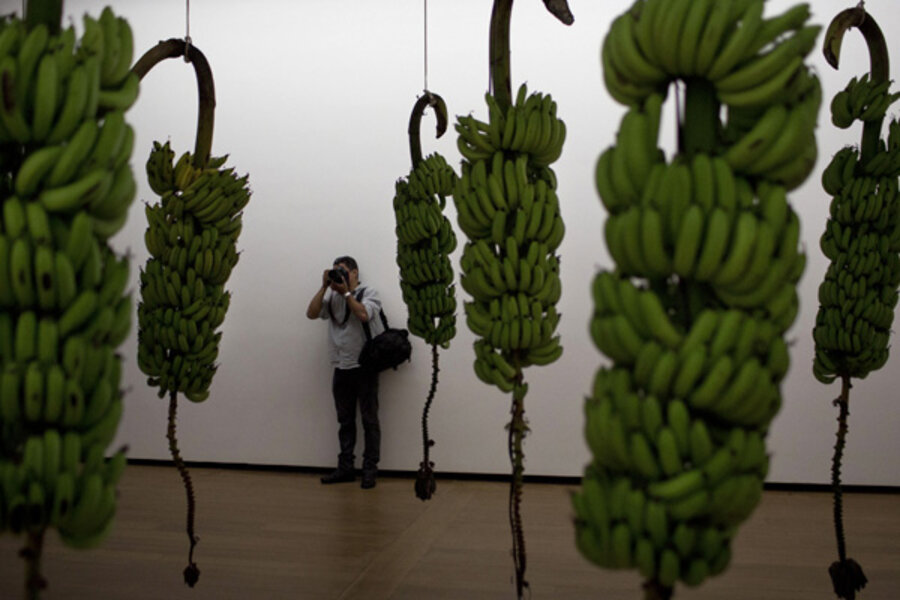Knowing neighbors through art: Rio houses new Latin American art museum
| RIO DE JANEIRO
Despite making up nearly half of the South American land mass and bordering every country on the continent but two, Brazil has paradoxically long looked further afield to Europe and the United States for its cultural references. While French cinema and all-inclusive trips to New York are commonplace, a carioca, or resident of Rio de Janeiro, is hard-pressed to view the same element of chic attached to other Latin American countries.
But Rio de Janeiro’s newly opened Casa Daros may change the direction upon which a carioca’s cultural compass is fixed.
The art house is the project of Zurich-based collector Ruth Schmidheiny and German curator Hans-Michael Herzog, who acquired more 1160 works from 117 contemporary Latin American artists over the past thirteen years.
“When we – precisely at the start of the new millennium – began assembling a collection of contemporary art from Latin America, hardly anyone from outside the Latin American continent was aware of its powerful intrinsic potentials," the two wrote in a publication marking the museum opening. "The view from outside of the art of Latin America was impaired by ignorance and arrogance."
As the works gained credibility through expositions in Europe, the pair began to look for a permanent exposition space in Latin America itself. They considered locations in Cuba, Venezuela, Colombia, and other Andean countries, but decided against them due to their political situations, violence, or lack of infrastructure. They also considered Buenos Aires and São Paulo, but determined that each already had a vibrant arts scene while Rio had space to grow.
“People [from Rio de Janeiro] do not have access to the culture of Latin America in the same way that they get Europe [and] North America,” says Felipe Mariano, a teacher who visited the museum’s exposition of contemporary Colombian artwork. He says that cariocas’ access to Latin America is often superficial.
“We have a relationship with Argentina because of soccer,” he says. “If you go to Bolivia, someone [from Rio] will say, ‘Are those the guys that play flutes in the downtown?’” Mariano says, referring to Andean immigrants who often sell handicrafts and play instruments in Rio.
The museum will bring in new collections from Zurich about every five months, and the inaugural exposition, “Cantos, Cuentos Colombianos,” (Colombian Songs and Stories) brings works from 10 contemporary Colombian artists. The pieces of work included in the inaugural show are largely preoccupied with the country’s violent history and loss of lives. A series of nude photos show a fit young man in poses reminiscent of Michelangelo's “David.” But rather than having one foot resting behind him, as does David, a closer look reveals that the model is instead an amputee.
Another work asks viewers to blow hot breath on a series of vanity mirrors, where silhouettes of Colombia's disappeared come into view.
“It is a neighboring country that we do not know anything about,” says Claudia Noronha, a publicist at the Casa Daros who was giving enthusiastic guided tours to its new guests. “It is an art that we Brazilians do not know."
Surrounded by history ... and art
In a city bustling with new Olympic, hotel, and condominium construction, the Daros collectors chose to carefully restore a neoclassical Catholic school for orphan girls, built in 1866, instead of housing the work in a flashy new building.
On the more than 118,000 square feet of the Santa Casa de Misericórdia, restoration crews painstakingly removed and retreated each wooden plank in its floor, maintaining 60 percent of the original flooring. They chipped away at ten layers of paint to restore the original walls of the school, discovering that they were made up of an imitation marble created by an Italian technique called escaiola. Marble holy water dispensers still adorn the entrance to the chapel, now the first room of the main exhibit hall. Century-old palm trees 130 feet tall elegantly demarcate the museum in the crowded Botafogo neighborhood that hosts it.
Museum staff say their goal was to engage in a model of historical renovation in Rio, where interest in restoring the dank colonial-era regions of the city is now budding.
Contemporary Brazilian artist Vik Muniz, famous for his use of garbage to produce portraits of trash-pickers in Rio de Janeiro – the subject of the Oscar-nominated documentary "Wasteland" – was invited to the Casa Daros to repurpose the trash from its restoration.
The statue of the saint Nossa Senhora das Graças atop the entrance of the museum was what caught Mr. Muniz's attention. Under his guidance, the restoration crew reassembled pieces of metal, wood and old furniture to recreate her image on the floor of the artist's hangar. A photo of the resulting image is part of Muniz's exhibition, "Pictures of Junk."
"You come into here and what is the first thing you see? This saint," Muniz said of the work. "So I thought: She is the most obvious thing in this place. The rest is art."






